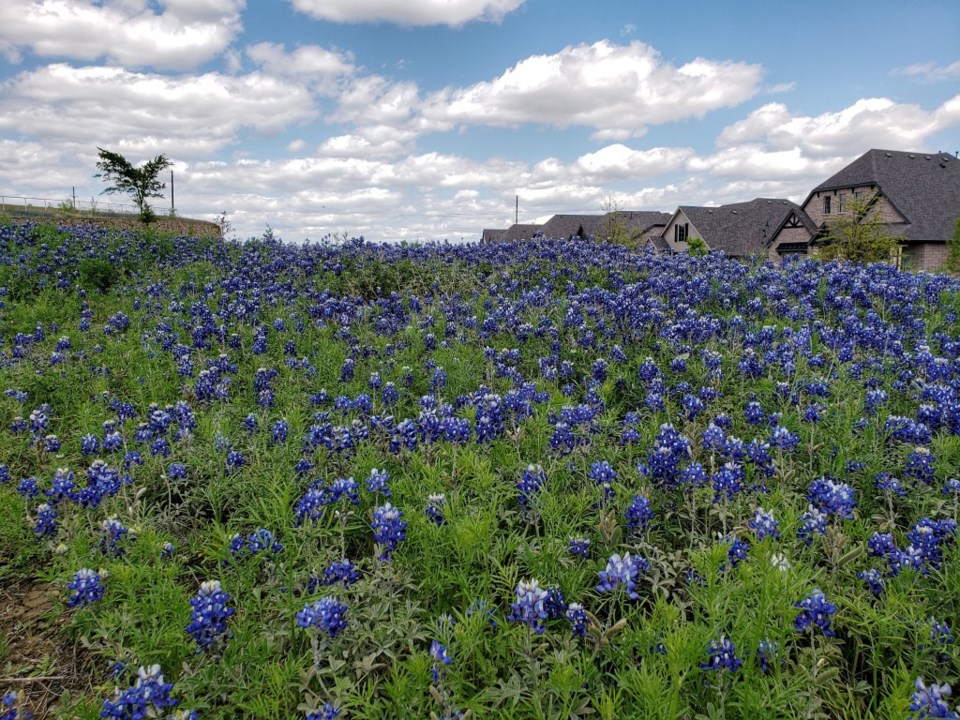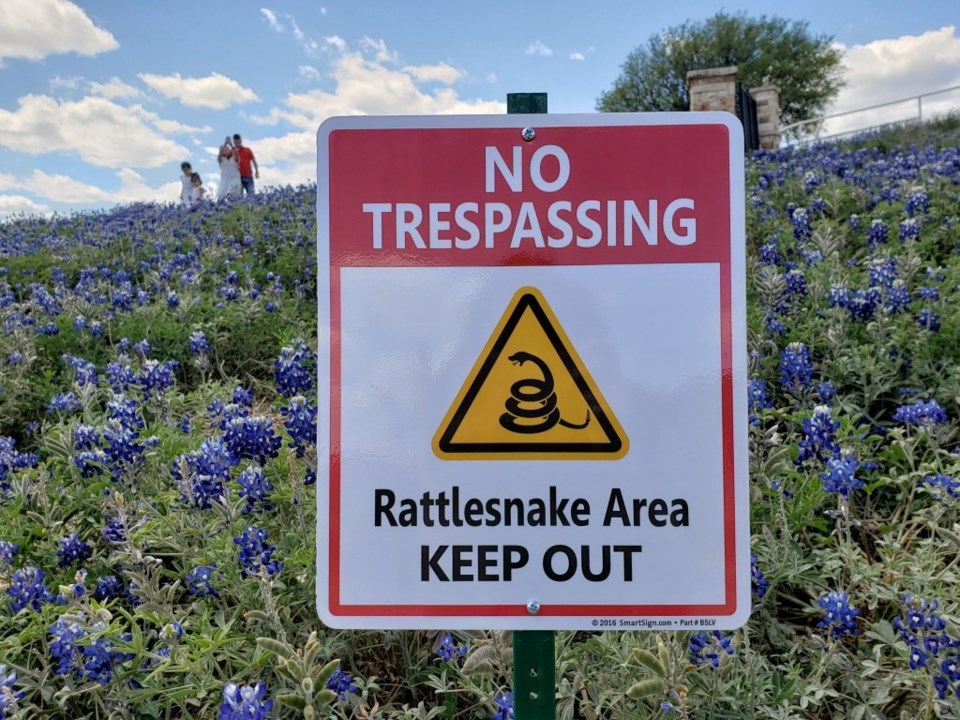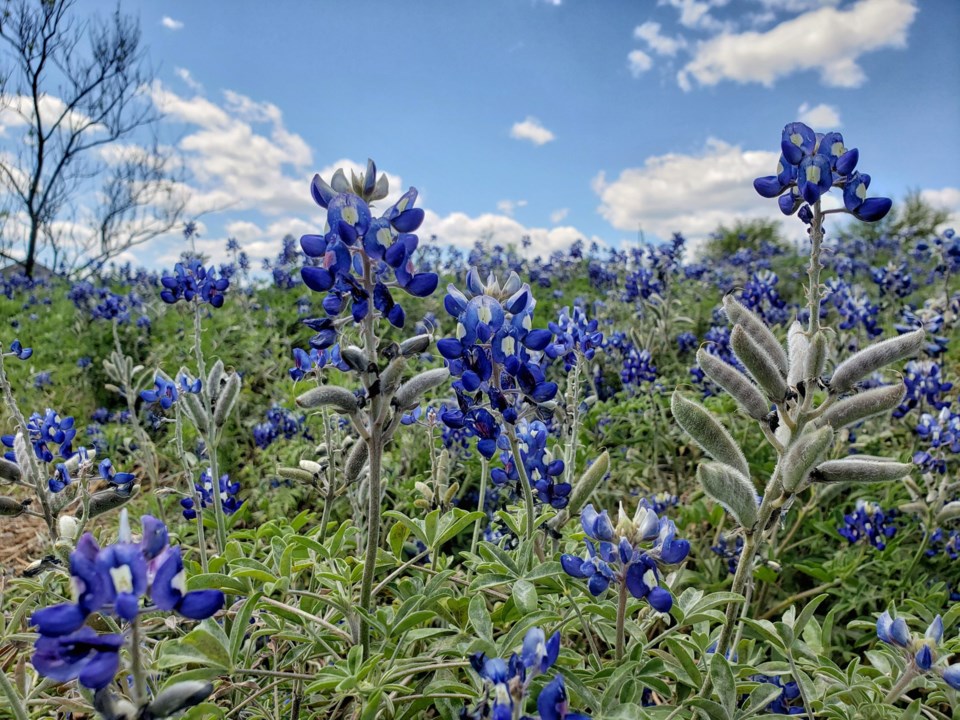The first time a real estate agent gave Stacy a tour of her future house in Frisco, she looked through the wide living room window and out onto a hill absolutely covered in a blanket of bluebonnets in full bloom. She fell in love. It was April, 2020. The back of the house faced the gates of Zion Cemetery, famous for its spring bluebonnets, and a hilly greenbelt outside.
“It was the most gorgeous thing; it was the reason we bought the house,” she recalls a year later.
Now, however, those same bluebonnets are a source of trouble, litter, traffic, and fear, as Texans are trespassing on private property, beyond signs warning of rattlesnakes, to take pictures with bluebonnets.
Stacy, who asked not to use her real name in this article, lived in San Antonio in high school, was somewhat familiar with Texans’ love affair with the bluebonnet season. She and her family have taken their obligatory pictures in the bluebonnets. But this year, when the season peaked in early April, she and her neighbors claimed that the craze has caused a major disturbance as unprecedented numbers enter their neighborhood, surrounding the Zion Cemetery, even trespassing onto their property to get their pictures.
“Neighbors told me there would be a row of cars behind their house constantly,” Stacy says. “They’re flowing into the neighborhood, they were blocking my driveway. Another neighbor had visitors over Sunday, but they couldn’t find a place to park. This is a neighborhood.”

The Bee in the Bluebonnets
The greenbelt outside Zion Cemetery isn’t the only hot bluebonnet location. One spot frequented by families and individuals is on a piece of corporate private property, one of many headquarters in Plano. A security officer, when asked about it, just laughed. Though he didn’t want to name the corporation, he confirmed that they saw everything—frisbee golfers, fishermen, geo-cachers, and of course, bluebonnet hunters.
He says he has known people to sneak around security and bring dogs, cats, kids, and professional photography equipment onto their property. The problem comes from possible property damage, but also from liability for the corporation. He says he’s seen up to 30 or 40 cars blocking private roadways onto their property for the beauty of their grounds. They have no trespassing signs, but many don’t realize that they are trespassing. Or they do it anyway because their purpose is fairly innocuous.
The state of Texas also promotes bluebonnet season quite a bit. It’s been our state flower since 1901, and statewide seeding efforts began in the 1930s by the Texas Highway Department. Then, in 1969, Lady Bird Johnson debuted the Texas Highway Beautification Awards, leading to a new wave of planting flowers along the highways. Texans are known for our state pride, and bluebonnets, as our state flower, enjoy a respected, beloved status. There's a feeling that the flower belongs to all of us, even if the land where they grow does not.
Every spring, they bloom along roadsides. It isn’t uncommon for families to pull over on the side of the road to take pictures of children and pets among them.
While bluebonnets are lovely and a key piece of Texas spring, people are overzealous. It becomes a safety hazard when people park on the sides of highways and roadways, climbing the steep inclines where bluebonnets bloom. They cross streets to access medians for just a hint of blue.
This year, the craze might have been exacerbated by the pandemic and our common desire to go outside. But it isn’t by any means new. In a 2013 New York Times article, a botanist with the Lady Bird Johnson Wildflower Center in Austin described the bluebonnet season as “a feeding frenzy every spring.” They wrote that at the time, 92% of the land in Texas was privately owned. Today, 95%, about 255,000 square miles, is privately owned, according to Texas Land Conservancy. Thus, the desire for pictures with bluebonnets naturally led to a surge in trespassing. Ignoring it is almost a rite of passage.
But it’s a dangerous one, to trampled bluebonnets as well as to photographers and families who simply want pictures. There are snakes waiting in the bonnets, stinging insects and ticks. That’s to say nothing of the dangers of parking on a public road.
Others have seen people parking on the highway, hazards blinking, on the busiest days of the Texas bluebonnet season.

Trespassing Season
Stacy’s neighborhood is tired of ending up on lists of places to find bluebonnets. While they love the annual bloom—their iron fences were likely built for optimal viewing—it has become a double-edged sword. Part of the problem is that Stacy’s is one of many houses that back up against a greenbelt between the neighborhood houses and the cemetery, a greenbelt she says is owned by the HOA. “All homeowners get a map of all the property and that’s one of them,” she says. But there's no fence, and even if there was, it's a difficult rule to enforce.
“We have a complete lack of privacy,” Stacy adds.
A week ago, she recounts an encounter with a stranger as she returned from visiting a park. When she let her dog out in the backyard, she spotted a man near her fence, stomping on bluebonnets to make a path. She asked him to stop.
“That’s common,” she says. Many neighbors have had to talk to people about stomping on the flowers. “This time I asked this guy not to do that and he started yelling profanity.” When she told him he was trespassing, she claimed, “He leaped at my fence, started climbing over it and my dog went crazy.” He jumped down, but Stacy says she is still shaken. “I felt like he was attacking me. It was scary. He said he was going to be back. I want to feel safe in my own home.”
One day, she counted more than 200 people behind her house. Another neighbor told her that a stranger had thrown his dog’s waste in her yard. “During workdays, there’s always someone back there. But that’s fine. That’s fine, I’d want to do the same,” she admits. “But on the weekends, there were hundreds of cars everywhere in the neighborhood. It’s so loud from people talking and screaming. People act differently in groups like that. Every year, it seems to get worse. This year is another level.” On Friday, she reported that the HOA planned to make No Trespassing signs.
Sure enough, two days later, on Sunday the 19th, there was a single new sign at the Zion greenbelt that did not go unnoticed. It warned visitors not to trespass—because of rattlesnakes. Around noon, after a very rainy few days, about a dozen cars lined up along the greenbelt. The Texas bluebonnet season had passed its peak. There was some trash left by other visitors, what looked like a tattered shirt, and take out bags. Feet have worn paths and bald patches down between patches of bluebonnets. None of the homeowners were in their backyards enjoying the weather, except a couple of dogs.
A few people read the sign. Some stopped to discuss it, but no one turned back. They walked out into the long, wide fields anyway. Groups, some with big equipment, scattered themselves throughout the blossoms, couples taking selfies, and families with young children, dressed all in white with professional photographers. Because the end of the season was near, the chaos that Stacy described had died down. But although the stream of visitors was much slimmer, it was steady and constant.
“Also just look at how many bald patches there are,” one person commented on a Facebook picture of the greenbelt in a group dedicated to photography spots in the area. “That is from people sitting in the flowers. It’s honestly really sad to see less and less flowers each year.”
Others theorized that the signs were just by homeowners who didn’t want people there, “to scare people away.” The sentiment seems to be that they shouldn’t make such a big deal about it, and should be willing to share the beauty of the bluebonnets.
In the end, the sign didn’t make a difference. The bluebonnet season in Texas remains a major occasion, wrapped up in a tradition of trespassing and risk-taking, harm with harmless intentions.
“So we can still shoot there?” Someone asked on Facebook in response to the new signs.
“Go for it,” another replied. “Just don’t go in the cemetery gates if they are closed and as always be respectful of the flowers.”
“So I can hop the fence?” another concluded. “Where should I park?”




